|
|
|
General Information about Mauritius
There is barely another country with such a legend reputation concerning holiday than Mauritius. For many people, Mauritius is the big paradise of which people only dream of because poeple even do not know where it is actually located; for others, Mauritius is the holiday island par excellence (there are numerous frequent guests who visit the island each year since decades); And many do only know the country because there is a high valued postage stamp from there. In fact, Mauritius is really a paradise of holiday country like barely no other. And most of the visitors of the island come back with a huge swoon, big enthusiasm and the firm believe that one day, they will come back. Why is Mauritius for many people the paradise par excellence, when everybody knows that there are many other places in the world like a paradise, for example in the Caribbean or in other islands of the Indian Ocean. In Mauritius, we enjoy a wonderful tropical climate, exactly the way one wishes it to be during the holiday. There are numerous palms of all kinds with coconuts and other fruits. The beaches are gorgeous, the sea waves run down at the edge of the coral reef, so that there are no big waves and no dangerous fishes close to the beach. Under water, there is a real fascinating coral paradise with colourful fishes as they were painted. And all this is in an island that is not any more an isolated spot on earth but meanwhile a modern small state with shopping possibilities and offers as we know them. And there are also the nicest inhabitants that one can image. One does not experience a falsely portraied friendlyness next to the tourists but rather a netural friendly warmness that simply makes one feel affected if one experiences it daily. One does not meet numerous young couples in Mauritius for nothing, who either married on the island or are just married some weeks ago. Apparently, Mauritius is the country for honeymoon par excellence. The hotels are also arranged accordingly for this purpose and offer eveything what is needed specially for those events. Situation and Size of MauritiusEverybody has already heard about Mauritius, either as a dream holiday country or maybe only about the very expensive stamp. But not everybody knows straight away where Mauritius is actually located. 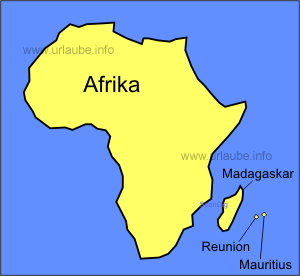
Thus, we will do a little world trip. We fly from Germany (from Munich and Frankfurt there are non-stop flights to Mauritius) in southern direction, arrive after one hour at the Mediterranean Sea and after 2-3 hours at the African continent. We fly over Egypt, Sudan and Ethiopia further to the south and leave Africa somewhere in Somalia or Kenia in direction to the Idian Ocean. We fly further to the south and/or rather south-west and pass after approximately nearly 10 hours flight the big island Madagaskar. Now, there is one hour left further into south-west direction and we land in Mauritius. We sit for nearly 11 hours in the plane and cover a distance of approximately 9000 km. Now we are in the Indian Ocean at the southern hemisphere. In the summer time, there are two hours time difference to our home country and in the winter time three hours, thus we nearly flew straightaway to the south, the outbound flight over night, the return flight from the morning until the evening. Mauritius has a surface of approximately 2000 km²; at the longest spot, the island measures 64 km and 47 km at the widest spot. Compared to the African continent, Mauritius is only a tiny dot on the map. Even compared to the neighboured Madagascar, the island Mauritius is a mite: Madagaskar is approximately 300 times bigger than the tiny Mauritius; Madagascar is even bigger as its former mother country France! Thus, Mauritius is a tiny paradise in the southern Indian Ocean. The big neighbour island Madagascar is at approximately 800 km distance and one hour flight; the distance to the south African continent is more than 2000 km, thus 3 flight hours. The next African countries are Msambik and South Africa. 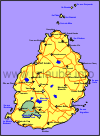
Mauritius has a small neighbour island named Rodrigues, that politically belongs to the state. With a length of approximately 18 km and a width of approximately 8 km, Rodrigues has not even a surface of 150 km², thus compared with Mauritius, it is again a mite. Nevertheless, it is the only place where an inhabitant of Mauritius can go on holiday without needing a Visum. Right there, thus not many kilometres away close to the main island, there are numerous small uninhabitated islands as the Ile aux Cerfs or the Ilot Gabriel, that also belong to Mauritius. At a little more than 150 km distance there is a further island named La Réunion. This island is a part of France, thus it belongs to the EU. La Reunion is one of the 88 Departments of France; of course, also the delegates from the far distant island do sit in the French Parliament. Thus, those who fly from Paris to La Reunion take a domestic flight. For a person of Mauritius, visiting the neighboured island is equal to a visit to the far distant Europe. As lonely and isolated the situation of the small Mauritius in the big Indian Ocean sounds, it is not true at all that Mauritius plays an insignificant role in íts region. After all, there are flights from four continents to this island: Europe, Asia, Africa and Australia. Mauritius is practically a communications junction in the southern Indian Ocean. The Origination of MauritiusWhen approximately 250 million years ago, the today's continents Europe, Africa, Asia, Australia, North America, South America and the Antarctic where stil in the shape of one single past continent that is called in the geology Pangea, where together, India literally stuck on the south-western tip of Africa, thereunder straight the Antarctic and in the west beside it Australia. Approximately 200 million years ago, the Indian Ocean started to develop and a huge fracture under the water was originated between Africa and the at that time neighboured India/Australia. The Australian-Indian plate drifted away from Africa, India adjoined in the north to our Eurasian plate and was therewith responsible for the origination of the big Himalaya-mountain. Between the African continent and Australia, the giant Indian Ocean started to open and still today it expands for a few centimetres per year. 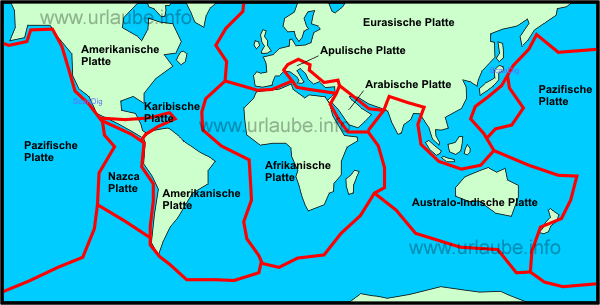
The Mascarene-Islands Mauritius, Reunion and Rodrigues are located at the border zone of the African and the Australian/Indian plate. Here, new lava continuously flowed from the sea depth out of the earth's interior aloft until one day it rised for several thousand metres from the earth. When this process was finished approximately 7 million years ago, Mauritius looked similar to the today's La Reunion: several thousand metres high mountains rised up from the sea. Numerous further volcanos marked the today's general appearance of Mauritius, see for example the volcano crater Trou aux Cerfs. Approximately 100.000 years ago, the last active volcano of Mauritius extinguished; Ever since, the wind, the rain, the sun and the storms work on the erosion of the island: some big pieces of rock got smaller and spread over, so that the islands becomes increasingly flat. Coral Reef Communities all around MauritiusThe island of Mauritius is nearly permanently surrounded by a coral belt. These surrounding branches of corals make the island to be a paradise the way we know it: they serve as wave breakers and keep the sea surge away from the beaches. While outside, the waves of a height of several metres mount up caused by the permanent south-east trade wind, in the area of the bathing beaches, most of the times it is calmed, although there is partly a strong wind blowing on the beach. Therefore, one can gaze at the many times metres high waves at the reef edges that slowly mount up and finally overturn. 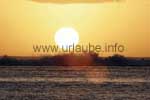
Corals are phytoid creatures that absorb lime from the sea water and make therefrom some imaginative scaffolds that protect them from the outer world. If the creature dies after some time, the lime scaffolds remain and new corals can continue building on them. Such corals partly look like a complex rod scaffold, but partly also like mushrooms or cauliflower; The imaginative shapes are nearly unlimited. Of course, such corals are a paradise for divers and snorkeling people, as not only the corals themselves are a dream to look at, but also the numerous colourful kinds of fish that find a safe shelter in them. The colonies of corals are always formed right under the ocean surface; they need a lot of sunlight for their growing. When the water level of the sea increases, for example after an ice age when some big amounts of ice melt and become liquid, the corals also grow upwards; When an island like Mauritius slowly sinks as a result of an erosion and flattens, the corals also grow accordingly uniformly. By this way, in the last 100.000 years, the coral belts of today were originated all around the island. And those who, are aware of this long lasting proces as divers, snorkeling tourists or swimmers are also aware of what they destroy by kicking on a piece of coral or by tearing a piece as a souvenir. This is the reason why the inhabitants repeatedly tell the visitors that they should not destroy "their" corals. History of MauritiusIt is not really clear who landed first on the island of Mauritius. What is for sure is that at the beginning of the 17th century, some dutch sailors started sistematically to approach Mauritius. But the dutch did not really seriously intent to inhabitate the island. They appreciated the high-quality wood and this is why they cleared the forests. Moreover, they put some goats in the island in order to catch them later on again as a proviant for the ships. The dutch did not stay a full century on the island; After their time, the forests were strongly cleared and the local fauna was damaged by the rats that jumped out of the ships. The French took the island over and from 1735, the famous Gouverneur Mahé de Labourdonnais took over the businesses on the island. Still today he is considered as the real founder of the island, his name is mentioned in many places. He ordered to build the harbour Port Louis and made Mauritius to an important supporting point of the French-East-Indian society. Only 9 years after his assumption of office, the first sugar cane factories started to work. Towards the end of the 18th century, there are some hard fights between France and England, from which England finally results as the winner. Mauritius falls into the hands of the English people while Reunion remains French. The English people abolished the slavery, let the trade of sugar cane really flourish and change the administration according to their system. Instead of the slaves of Africa they take workers from India (known as Kulis). Mauritius immediately rise quickly through the ranks, although there were at the times of the world wars repeatedely some strong drawbacks. Up to the year 1968, Mauritius remained an English colony and got then the independency. The first Prime Minister was Sir Seewoosagur Ramgoolam, afterwards, the airport was named after him. But Ramgoolam was subordinated to the Queen; Not until 1992, the Mauritians decided to abolish the Monarchy. Population and ReligionsThose who are on holiday in Mauritius will soon notice that here, different ethnic groups live together in the smallest possible space. It gets the most clear during a city viewing in the capital Port Louis, where one comes across to dark skinned Africans and Indians as also bright skinned Europeans and even Chinese people. In fact, in Mauritius, four ethnic groups live together in harmony, and this in a country where not much time ago, the upper white upper class manorially dominated slaves of Africa and/or workers of India. Under the four main ethnic groups, the franco-mauritian is the smallest one. It consists on a small number of an original French descent white upper class which entecestors were colonial masters and merchants. Still today, these people operate profitable sugar cane plantation and/or have settled into the new sectors as the tourism. Approximately a quarter of the inhabitants of today have African antecestors that once were forwarded in ships as slaves into the country. The biggest part of the population are the Hindoos descending from India, that once came as workers to the country after the slavery was forbidden. The fourth and rather tiny ethnic group are the Chinese that came as merchants into the country, thus were always independent. Today, we can really admire in Mauritius how these ethnic groups that are full of contrasts live harmonically in a democracy, vote together a president and sit together as a matter of course in the buses and the restaurants. But the process of the cultural intermix is far from being finished: It still does not happen oftenly that a Hindoo marries a Muslim or a Christian; the different groups rather from their families among themselves. In respect to the different ethnic groups there are also different religions on the island; Respectively to the portion of the population, the Hinduism, is with more than 50%, the biggest group of religion of Mauritius. We repeatedely notice during our island tours, that no matter how tiny a place is, there is always somewhere at the roadside a small Hindu temple. The second biggest group of religion are, with approximately 25%, the Christians, mainly the white population but also a lot of people who converted in the course of the past century. We only find some christian churches in bigger places, thus much more seldom than the Hindu-temples. With approximately 17%, the Muhammadan are the third biggest group of religion; in some bigger places we always find a mosque; there are approximately 100 mosques of different size spread over the whole island. A small religion group is finally formed by the Chinese buddhists. Languages in MauritiusIn Mauritius, the official language is English. This is very nice for nearly all German people, as nearly all do speak a little English. Thus, in nearly all places of Mauritius, one can expect an answer by speaking English to someone. But there is also to know that being English the official language, it still does not mean that all Mauritians speak fluently English and also like to do it. In total, there are more than 20 languages that are spoken in this small island. English is the official language in which the contracts are written and in which the exams are done in the universities. Also the official documents are written in English language. But the mauritian upper class as also the well-educated part of the population prefers to speak French instead of English. Moreover, most Mauritians are more interested in France than in England, although the English colonial era is much more recent than the French one. If it is about culture, literature and arts, people prefer to take France instead of London. Is it only the love to the French people that makes the Mauritians prefer the French language instead of the English one or are there some other reasons? Among themselves, the Mauritians speak Creole. It is a language of its own that can be considered as a dialect of the French language, but actually is an independent language. Creole is spoken by more than 10 million people all over the world, for example in the Island States as the Seychelles, La Reunion and the French Caribean Islands. It is indeed always Creole, but there are numerous modifications and no uniform spelling. How was this language originated? During the French colonia era, it was strictly paid close attention that during the employment of slaves, the slaves who work together belong from different countries so that they could not communicate with each other and plan some revolutions. But with their squires, the slaves somehow had to talk in French. Thereby, a language of its own was developed by the slaves that had similar words and a similar grammar to the French language. The philologists should argue wether Creole is a language of its own or a dialect of the French language. What is in any case for sure is that both languages are very similar. Thus, as Creole is the family language of the Mauritians, it is of course easier for them to learn and speak French than English. Economy and Tourism of MauritiusThose who cross the island by car or by bus will soon recognize how money is earned in Mauritius: only a few metres behind the coastal line, the nearly endless appearing sugar cane plantations begin that cover approximately 50% of the surface of the island. Not before some steeper hills and mountains and/or the highlands appear, the big sugar cane plantations end. The biggest portion of the sugar is exported to the EU and only a small part remains on the island for the self supply. 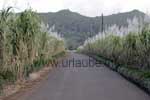
During the excursions to the capital and to other regions of the island one repeatedely comes across to factory sales of fashion items as t-shirts, shirts, and dresses. One never knows if one gets original brands or cheap copies offered. But what is for sure is that the textile industry is one of the three major economic sectors of the island. Big renowed brand manufacturers have their manufacturing plants in Mauritius, and the articles of this brand are, of course, much more cheaper to get on the island as at home. And, of course, the tourism should not be missing by talking about the three major economic sectors of the island. In Mauritius, a high-class tourism is offered; the quota of luxury hotels is higher than in other holiday places. The typical tourist strongholds are avoided. While in other holiday regions as for example in the Balearic Islands, there are partly more tourists than inhabitants, the number of tourists in Mauritius is, compared to the number of the inhabitants of the island, still very low. The long aimed target of half a million tourists per year is indeed achieved after the turn of the millennium; but with a total population of more than a millikon, this number is still low. Those who notice that in the most hotels most of the tourists speak French should know that each second tourist comes straight from France or from the neighboured island Réunion. Only 10% of all tourists are German, approximately further 10% are Englsih and some other 10% are English speaking South Africans. One word more concerning the fishing: those who do snorkeling or dive in the waters around Mauritius could think that the fishing is an important economic factor of the island. But it is far away from this. Despite the huge sish quantities all around the island, the local fishermen do not even catch a quarter of the fishes needed by the inhabitants of the island for the self supply. Thus, the biggest part is imported, for example from the close archipielago of the Seychelles. The Flora of MauritiusIt is hard to believe that a few hundred years ago, before the first dutch came to the island, Mauritius was an island abundantly covered with tropical rain forests. Among numerous tropical plants, some precious wood trees like teak and mahoganygrew. These solid precious wood trees resisted any storm that went over the island: the strongest cyklone could not destroy these stable woods, and even more: these massive trees also protected the other plants and palms all around them. This natural balance got lost when the dutch sailors cleared one mahogany tree after the other and sold them as high-quality wood in Europe. The high-quality wood seemed to be inexhaustible, but it wasn't. After the massive trunks were cleared, the heavy storms had an easy game with the more fragile plants and destroyed some parts of the rain forests. A major part of the tropical primeval forest was then destroyed by the arrangement of sugar cane-plantations. Today, 50% of the whole surface of the island is covered with huge sugar cane fields. 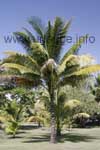
The new trials to cultivate precious wood trees on the island fail these days, as the trunks, when they are still thin, are easily broken by the cyclones. The Filaosare more resistant against the strong wind, as these light confers are elastic and simply bend with the wind; the same applies to the thin sugar cane plants. There are a lot of filaos close to the beach, for example in the Ile Aux Cerfs, as its roots are able to expand also in the light salty sandy ground. If we today admire some big trees in the island, most of the times, they are coconut palms, from which not only the coconuts are used as nutrition. From the leaves of the palms, roofs and coverings are made and from the trunks roof girders and supports are made. Another kind of palm we repeatedely come across to is the Tree of the Travelers. These banana plants which leaves split fan-shaped from the trunk can save some rain water in their leaf sheath. Thus, a lonely traveler in such an island only needs to make a little hole in such a leave and will be rewarded with a jet of fresh potable water. Finally, the Banyan-tree should be mentioned, from which we saw some splendid specimen during our tours, for exmple amidst the capital Port Louis in the Company Garden or during our North tour at the Cap Malheureux. The ananas is nothing new for the Europeans, but nevertheless I saw in Mauritius for the first time how the Ananas grows in the nature: the shrubs are approximately half a metre high in which core the sweet fruit grows. I also saw in Mauritius for the first time in my life some tea plants and coffee trees. The Fauna of MauritiusTourists only come across to a dodo, the most famous animal of Mauritius, in the souvenir shops, as this former bird weighted up to 20 kg became extinct long time ago. The dodo-bird (local denomination), that had no wings, could not defend himself against its new enemies brought by the dutch and French colonialists as Ziegen and pigs. The smaller newcomers as rats and monkeys nourished on their eggs, so that soon there was no offspring any more. Thus, the most famous animal of the island is extinct since centuries. The same also happened to several other kinds of birds that could not continue being alive after the change in their environment. Those who hike in Mauritius will probably see one or two boas. But these little serpents are not dangerous, as they do not have any poison fangs. But what every tourist will surely see are geckos. We even had one in our hotel room that scared us a little during our first night with its fizz noises; Geckos are harmless small reptiles that scramble alongside the walls and the ceiling. They rush as quick as a flash on small insects and eat them. They never dare to get close to humans; during the day, they disappear in small grooves behind walls or cupboards. Those who do some tours in the island will see a lot of straying dogs on the streets that partly only go aside when the drivers strongly pressing the hooter. What is outstanding is that all these dogs are of approximately the same size although they are of a different race. I never saw that such a wild dog came close to a human being, they simply stray around and look for food. This is exactly what also the wild cats do of which we had a few in our hotel complex that visited us regurlarly during our breakfast and dinner with a rumbling miau. But the most beautiful creatures of Mauritius are in the air and under the water. There are some kinds of parrots that are eye-catching because of their colourfulness. Those who want to see some colourful fishes only need to swim in direction to the coral reef and to look through some diver eyeglasses at the coral Korallenstöcke. Mauritius has such a picturesque underwater world that one might think that here, an underwater-paradise was picture-perfect made. 
Copyright: Patrick Wagner, www.tourist-guide.biz |
||